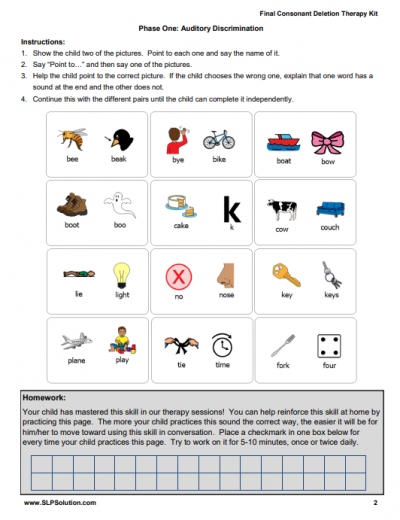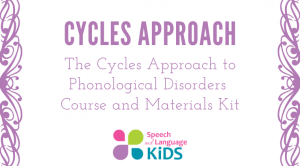What is Final Consonant Deletion?
Final consonant deletion is a phonological process (pattern of speech errors) where a child drops off the ending consonants of all words.
Final Consonant Deletion Examples:
- “dog” becomes “dah”
- “cat” becomes “ca”
- And “Please Mom, can I eat some eggs and toast?” becomes “Plee mah, ca I ee suh eh a toe”?
Final Consonant Deletion Age of Elimination:
Final consonant deletion is a very normal speech pattern for young children. By dropping off the last sounds of words, young children are able to let us know what they need without over-taxing their speech systems. However, after a certain age, we expect children to stop using this process/pattern and start including all of their sounds.
The age of elimination for final consonant deletion is 3 years. We expect that by a child’s 3rd birthday, they are not still continuing to drop final consonants off of their words. If a child continues to use final consonant deletion much past this age, he/she may need speech therapy to learn to include final consonants on words.
Final Consonant Deletion Goals:
Here’s an example of a great set of goals you can write for a child who needs to eliminate the process of final consonant deletion:
By the end of the IEP cycle, Client will eliminate the phonological process of final consonant deletion by producing final consonants in the therapy room with no more than 5 omissions of final consonants in 15 minutes of conversation with 2 verbal reminders as needed on 3 consecutive data collection days.
Benchmarks:
-
- Auditory Discrimination: Student will receptively identify the difference between two minimal pair words where the words sound the same except that one word has a final consonant and the other does not (example: bee and beak) with at least 80% accuracy.
- Production in Single Words: Student will produce single words with final consonants with at least 80% accuracy.
- Production in Phrases: Student will produce final consonants in 2-3 word phrases with at least 80% accuracy.
- Production in Sentences: Student will produce final consonants in sentences with at least 80% accuracy.
Final Consonant Deletion Activities
Fortunately, the therapy to fix final consonant deletion is pretty straight forward. You just need to help the children hear that there definitely are consonants on the ends of many words and then help them say those final consonants. These final consonant deletion activities will gradually help a child learn to use those final consonants. Use the activities below in order. Don’t move on to the next activity until the child has mastered the previous one.
1: Auditory Discrimination for Final Consonant Deletion
The first thing you will need to do is help the child hear the difference between words that have final consonants and words that do not. To do this, you will need to come up with some pairs of words that are exactly the same except that one has a final consonant, and one does not. Fortunately for you, I have listed as many as I can think of here:
Final Consonant Deletion Words:
This final consonant deletion word list shows examples of minimal pairs – words that are exactly the same except that one word has a final consonant and the other does not. Use these word pairs to help the child hear the difference between words with and without final consonants.
- Baa (like a sheep noise…but only if you say “baa” the same way you say “bag”)/bag/bat/bad/bass/bath/back
- “R”/”arm” (technically /ar/ is a rhotic vowel, though if the child is having trouble with /r/, skip this one)
- Bee/beak/beet/beam/beast/
- Bye/bike/bite
- Bow/boat/bone
- Boo/boot/boom
- “K”/cake/cape/Kate/case/cane
- Cow/couch/count/cows
- Dry/drive
- Four/fork/fort/form/force
- Key/keys/keep
- Lie/light/life/lime
- No/nose/nope/gnome/note
- Play/plane/plate
- Sew/soap/soak
- Tie/time/ties
- Tree/treat
- Purr/purse
- Go/goat
- Me/meat
- My/mice/might/mine
- You/use
- Two/toot/tune
- We/week/wheel/wheat/weep
- Tea/tease/teen
- Boy/boys
- “Q”/cute
- Toe/toast/toad/tone/toes
- Shoe/shoot/shoes
- “C”/seem/seed/seat
Auditory Discrimination Game:
Place two pictures in front of the child from the same pair. Tell the child what each picture is called and then have him close his eyes. Hide a penny (or a piece of candy) under one of the pictures. If it sticks up and is obvious to the child, use two paper cups and put the cards on top of the cups and the candy/penny under one. Then, have the child uncover his eyes and tell him which picture to look under. (Or, if you don’t want to do the penny game, just tell the child to point to one picture or the other).
For example, if you had “bee” and “beak” out, you could say “look under ‘bee”. Make sure you exaggerate the final consonant when you say it. If he looks under the wrong picture, say “Oh listen, that word has a final/end sound (or doesn’t have a final/end sound)” and exaggerate the sound for him again. Keep doing this until the child can correctly pick the right picture each time. The child may be able to do this right away or it may take several weeks. Keep at it!
2: Eliminate Final Consonant Deletion in Single Words
Once the child can hear the difference between words that have final consonants and those that do not, it’s time to start having the child say those sounds in single words.
Put two words from a pair in front of the child again, but this time, tell the child that he will have to tell you which picture to look under. Have the child close his eyes and then you hide the penny (or candy) under the picture with the final consonant (always under the one with the final consonant). Have the child open his eyes and this time have him tell you where to look.
The child will probably say the word without a final consonant first so repeat the word back to the child and look under that picture. (For example, if you’re doing long and short sounds with the pair “bee” and “beak”, hide it under the “beak”. When the child tells you to look under “bee”, say “bee. Ok, I’ll look under “bee”. Oh, it’s not under bee”). Then, have the child guess again. If he says the word without the final consonant again, repeat his error back to him, and then model the correct pronunciation of the word. In our example, you would say “you said ‘bee’ but it’s not there. Do you mean, beaK?” Then, help the child say the word with the final consonant so you can look under that picture.
3: Final Consonants in Phrases and Sentences
Now that the child is able to produce the class of sounds in single words, you are ready to move on to having the child say final sounds in phrases and sentences.
Use the card pairs from before and have the child say two sentences, one with each word in the pair. For example, he could say “I see a bee. I see a beak”. You could also have the child say one sentence with both words. Make sure that the child correctly produces any final consonants that occur in the sentence. Continue to ask the child to make up sentences with other words and make sure that all final consonants are present and accounted for. Keep practicing this until the child is consistently using final consonants in simple sentences.
4. Final Consonants in Conversational Speech
Once the child knows how to produce final consonants in sentences, you can start working on conversational speech. Here is some information about working on sounds in conversation:
Additional Resources for Final Consonant Deletion:
Check out my additional resources for eliminating final consonant deletion here:

About the Author: Carrie Clark, MA CCC-SLP
Hi, I’m Carrie! I’m a speech-language pathologist from Columbia, Missouri, USA. I’ve worked with children and teenagers of all ages in schools, preschools, and even my own private practice. I love digging through the research on speech and language topics and breaking it down into step-by-step plans for my followers.
Fun Fact: I enjoy yoga and meditation. I’m not particularly good at either but I don’t let that get in my way. I do the poses that feel good and I spend a few minutes focusing on my breath even if I can’t meditate for very long. I am perfectly fine with my imperfect practice as long as I’m focusing on taking care of my body.
Connect with Me:
Listen to the Podcast Version of this Information Here:
Podcast: Play in new window | Download | Embed
Subscribe: RSS










Have a question on final consonant deletions.I have a student that has trouble with final consonant deletions as well as /k,g,f/ productions. He is now 4-1/2 and he is putting sounds at the end of words especially ones that are within his developmental age but may say reag/read, or pik/pig etc. Would I say he is no longer deleting final consonants but gets confused with backing and fronting processes???? We also have worked on syllable reduction in words and he is now producing most 2-syllable words but substituting wrong sounds. At least he is putting some kind of sound in these words even if it is not correct. So what is next? in the phonological process
I have a student age six who skips the second consonant m. Leaves out the m in name (says na), leaves out m in I’m (just says I). However he doesnt have a problem with bit, pop etc.
Is this normal?
Hello! Thank you so much for reaching out. Unfortunately, we get a ton of questions every day about how to solve specific speech/language problems. Since we have such a small staff, we aren’t able to answer every question that comes through on the website, social media, or via email. If you are a parent, we suggest you reach out to a local speech-language pathologist who can work with your child directly and answer your question.
If you are another speech-language professional, we have created a membership where we pay a full staff to answer questions like this on a regular basis. We would be more than happy to answer your question inside the membership program. We’re able to answer more questions in here because we have a full library of questions that we’ve already answered so our staff can either link you to the answer if it exists, or write you a custom response if needed. We’d love to see you inside the membership!
Click Here to Become a Member: https://www.slpsolution.com/pediatric-signup/
Free download link is not working.
Hi, Anna-We have emailed you a copy of the requested materials. Please let us know if you need anything further.
Is there a tool we can use to assess what sounds our student might specifically be having trouble with? An assessment of some sort?
Yes! I have an articulation screener you can use! https://www.teacherspayteachers.com/Product/Informal-Articulation-Screening-Kit-Complete-Screener-for-All-Speech-Sounds-2576578